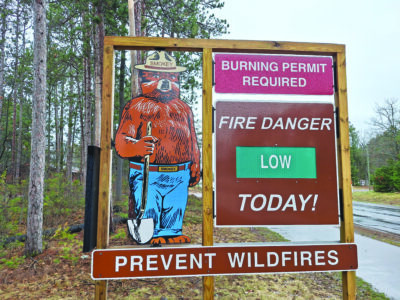Talking Turkey
KBIC holds activity for youth

Ben Garbacz/Daily Mining Gazette KBIC Natural Resources Department Wildlife Biologist Blake Chosa teaches children how to use turkey box calls at the Youth Turkey Activity Friday. The event was aimed at educating children on turkey hunting and to inspire them to become hunters themselves.
L’ANSE — On Friday workers members of the Keweenaw Bay Indian Community (KBIC) Natural Resources Department taught tribal and non-tribal children the basics of turkey hunting. The Youth Turkey Activity event was sponsored by the Great Lakes Indians Fish and Wildlife Commission.
The activity took place at the KBIC Teaching Facility in L’Anse and highlighted facts about turkeys, reviewed tribal and state turkey hunting regulations, demonstrated a turkey hunting setup with a decoy and blind, showed how to use a turkey box call and how to process a turkeys. KBIC Natural Resources Department Wildlife Biologist Blake Chosa said the event was important to attract youth to hunting.
“We think it’s important for our youth in our community to keep and maintain the subsistence of living practices of our ancestors,” Chosa said. “We need more youth in the woods. It’s a dying tradition.”
Chosa said children and teenagers who become interested in hunting in families not familiar with the practice can hopefully inspire them to take up the activity. He also said the act of hunting is needed to keep the turkey population healthy and prevent it from expanding too much and increasing the chances of the population developing things such as diseases.
“So it’s a win for both our youth and for the environment,” Chosa said.
The event began with the children learning basic turkey facts — the differences between toms, jakes and hens (mature males, young males and females), what different types of sounds made by turkeys communicate to each another, what time of year mating season occurs and when egg laying happens. KBIC Natural Resources Department Outreach Coordinator Austin Ayers explained to the children how turkeys are important to Anishinaabe culture.
“With the turkeys, there’s a lesson about how they choose their beauty and how they dance and how they treat their mates in a show of ‘look at my brilliance’ to be able to attract their mates,” Ayers said. “And so it was a lesson for the Anishinaabe to practice their beauty and the way that they approach someone so that they know they’re serious about becoming partners.”
After the lessons, the children went out to a tree line to learn how to camouflage themselves for turkeys and how to set up a decoy. When they returned, they all were given turkey box calls where they could practice two different types of call. Chosa said the active nature of turkey hunting makes it more interesting to potential young hunters.
“It’s a very interactive type of hunting. So giving them (children) a call and teaching them how to call is something they can do when they’re out in the woods, because it’s a lot more interactive. Traditional deer hunting in the U.P. is just sitting on a bait pile and being quiet. For turkey hunting you’re going around the woods and you’re making making noise,” Chosa explained.
Afterwards, Chosa brought a turkey he shot the day before and taught the children how to remove breast meat from the turkey. The breast was cut up and sent home with the children, along with Chosa’s recommendation on how to cook it.
“Make turkey strips, just like chicken strips, cut length diagonally lengthwise the breast meat, tenderize it a little bit, soak it in milk for about an hour or two, and then just make a batter of any kind, dry flour type of thing, and then just deep fry it or pan fry it,” he said.
This is the second year of the event and Chosa is hoping to see this become an annual activity. He said it was encouraging to see the number of children attend go up compared to last year. Until next year, the children in attendance will have new knowledge of turkey hunting, and they have turkey calls given to them at the event to keep their interest alive.





